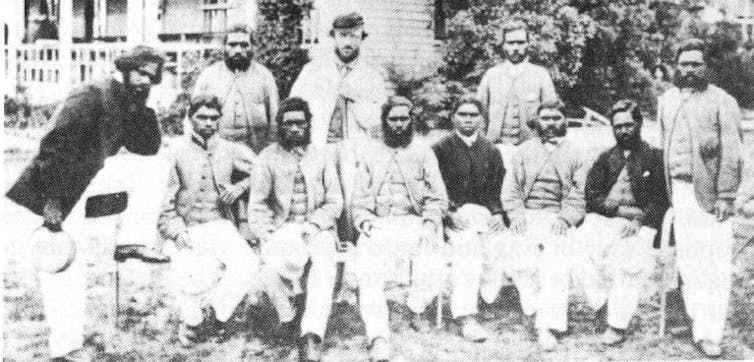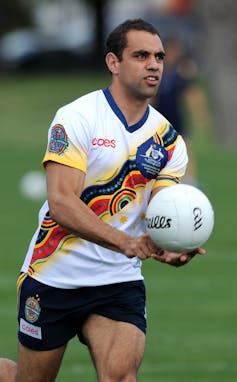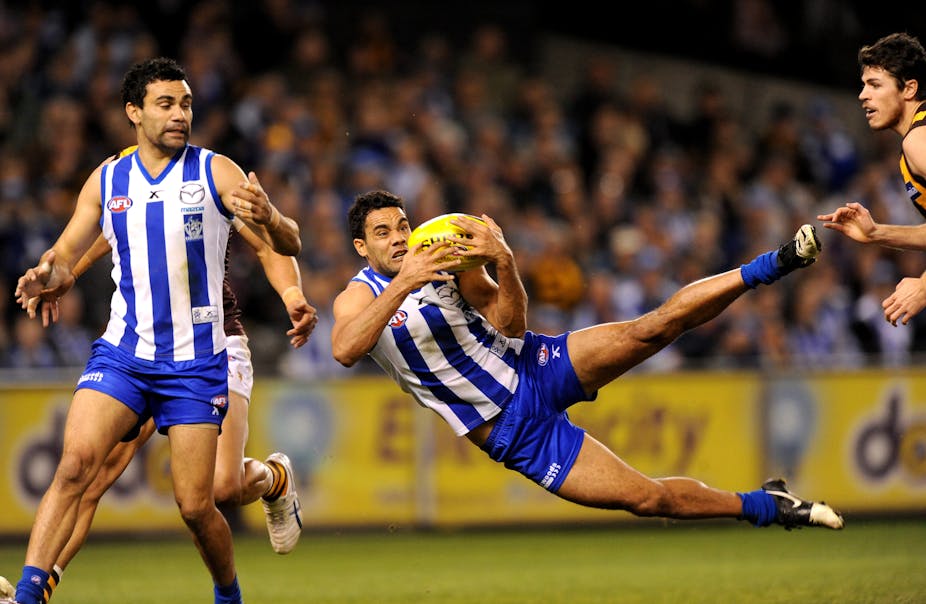The AFL’s Indigenous All-Stars’ current tour of Ireland is the third overseas sporting tour by an all-Indigenous Australian team. The first took place 145 years ago with the 1868 Aboriginal cricket tour of England. In between was the 1973 tour of a rugby league side to New Zealand.
The 1868 cricket squad became the first organised group of Australian cricketers to tour overseas. Unlike the touring sportsmen of today, we don’t know why these men got on the Parramatta in early February 1868 and headed into a fate that was at best uncertain - and possibly doomed. The Aboriginal cricketers came from the western districts of Victoria.
The towns known as Warracknabeal, Ararat, Moyston and Horsham were the traditional homelands to the Jardwadjali and Djab Wurrung people. There is no real trace - no diaries, no blogs, no Tweets - of any of the players’ thoughts while on tour.
What we can be sure of is that the men on the 1868 tour were brave. As sports historian Bernard Whimpress reminds us:
It is well to remember that at the time when Aboriginal heads were being collected in European museums the cricketers must have seemed something like living museum pieces.
We know that the trip by sea lasted four months and the team were in England for nearly 12 months. While on tour they played 47 games in total. There were 19 draws, 14 wins and 14 losses. The best of the batsmen and the bowlers were Johnny Mullagh (Unaarrimin) and Johnny Cuzens (Zellanach).
Historian David Sampson has written that the displays of Aboriginal weaponry during the tour of Britain were more appealing to many spectators than the cricket itself, as demonstrations of boomerang and spear-throwing took centre stage.
Wotjobaluk warrior Dick-a-Dick’s (Jungunjinanuke) challenge to the crowd to throw cricket balls at him elicited the most interest. As the projectiles rained down and whizzed past his head, Dick-a-Dick was cool and poised as he moved easily out of the way or deflected the balls with consummate ease with his thin shield.

By contrast, the Indigenous AFL players who will take part in the two-Test tour of Ireland will undoubtedly take to social media to provide fans with a rolling, subjective commentary. As AFL executive Gillon McLachlan indicated when the concept was announced in mid-2013, it was due to the drop in gate receipts and a lack of interest shown by the AFL’s stars to participate in the hybrid game that saw the All-Stars considered for the series.
Having been invited by the AFL Players Association to the last three camps - in Darwin, Sydney and Alice Springs - what is clear to me is that the All-Stars team concept has worked. Not only has it provided the local communities with the chance to see their AFL heroes in the flesh at schools and in town, but it has enabled the Indigenous players at the elite level to come together to chart their destiny. This is something the 1868 cricketers desperately craved and would never realise.
Some people were sceptical as to what the purpose of the tour to Ireland was meant to represent. Some came out and said it was reverse discrimination. One football fan on a popular sport website mocked:
2013 Aboriginal/Torres Strait Islanders v Ireland; 2014 Players of European Heritage v Ireland; 2017 Tattooed Players v Ireland; 2018 Players without an E in their Surname v Ireland.
The subtext this was simply: “why aren’t we taking out best side?” Even the Irish Gaelic Athletic Association wanted the very best players to play - not some second-string team. Indigenous football legend Barry Cable was reported to have been not entirely comfortable with the concept, saying:
We don’t need to put a wedge between them by doing something like that.

Paradoxically, when I interviewed Cable for my book Legends (on the AFL’s Indigenous Team of the Century), he strongly indicated he would have loved to have played with the team considered to be the best Indigenous players from 1905 to 2005.
With names like Buddy Franklin, Steven Motlop, Mathew Stokes and Daniel Wells selected in the squad, we can be sure that this is no second-tier team. This side will be the pride of Australia and a team who will take their responsibilities as professional players and Australian citizens seriously.
I will be watching retiring pair Aaron Davey and Nathan Lovett-Murray closely. For Davey, playing with the Melbourne Demons - the club of Australia’s first sporting tragic, Tom Wills - is significant. Wills was meant to take the 1868 tour to England but did not. For Lovett-Murray of Essendon, the club to win the first VFL premiership and home to many great Indigenous players (such as Michael Long), the tour is significant. It will be a great way for them to round out their careers on a positive note.
Rather than lament who is missing, it would be good if we as Australians accepted this series for what it is, and simply enjoyed the chance to watch some of our best players - descendants of the oldest living culture in the world - strut their stuff.

